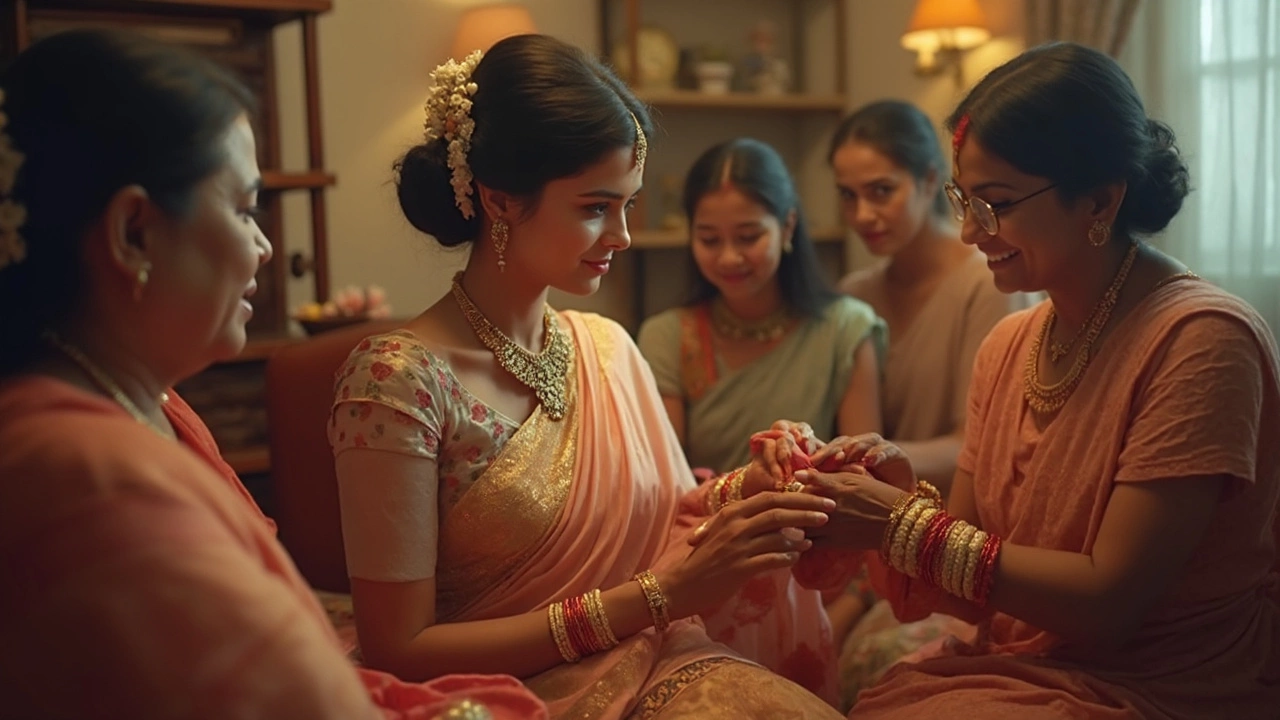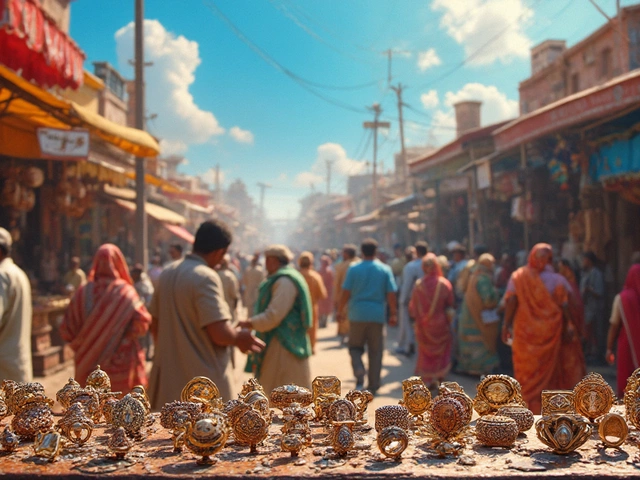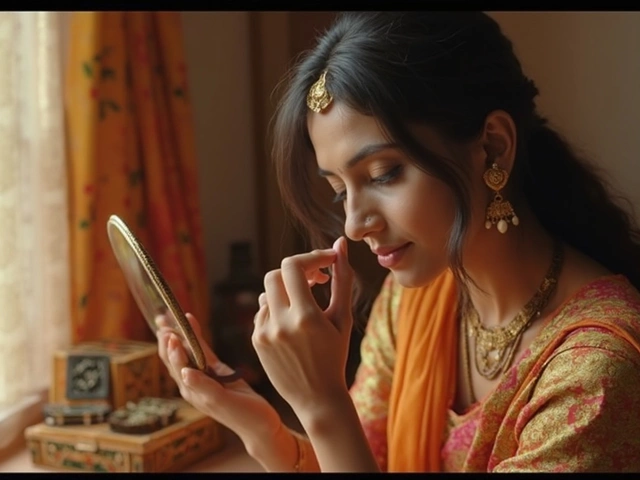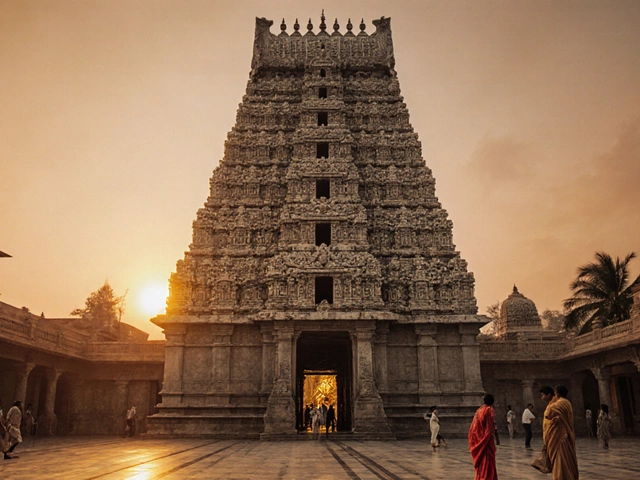
Ever wondered what those colorful bands on a North Indian bride's wrists mean? They're called chooras, and they carry more significance than just being pretty accessories. Dive into the vibrant world of traditional Indian weddings, and you're bound to spot these bangles taking center stage in many bridal outfits. But here's the scoop: wearing these bangles isn't just about style.
So, what exactly is choora? Typically featuring a symphony of red and ivory bangles, chooras are a staple in Punjabi weddings. But their appeal doesn't stop there. They're also adored in neighboring cultures, each adding its unique twist to the tradition. Imagine them as a cheerleader for new beginnings, ringing in optimism and joy as a bride starts a new chapter.
- What is Choora?
- Significance of Wearing Choora
- When and How is Choora Removed?
- Modern Trends and Interpretations
What is Choora?
In the vibrant tapestry of an Indian wedding, the choora stands out as a symbol of joyous beginnings and cultural richness. A set of sacred bangles signifying a bride’s married status, it's most commonly worn in Punjabi and other North Indian weddings. Consisting usually of red and white bangles, the choora holds a special place in the ceremonies and hearts of the families involved.
The choora is not just an aesthetic piece but a deeply rooted tradition that ties generations together. Typically, a bride dons the choora during a special ritual led by maternal uncles who place the bangles onto her wrists while whispering blessings. This practice is believed to usher in happiness and fortune.
Mona Singh, a cultural anthropology expert, explains,
"The choora serves as a reminder of the bride's new role and the bonds she creates with her new family. These bangles are like a badge of honor, worn with pride."
Traditionally, a bride would wear her choora for at least 40 days, up to a year, depending on personal and familial beliefs. This period varies and symbolizes the integration and acceptance into her new family.
Modern adaptations see chooras featuring embellishments like kundan stones or even gold-plating, blending tradition with contemporary fashion. Despite the variations, its underlying significance remains unchanged, adding layers of meaning to its beautiful form.
Significance of Wearing Choora
The choora is more than just a fashion statement at Indian weddings. These vibrant bangles are a symbol of newlywed bliss in North Indian culture, notably among Punjabis. The striking colors—typically red and white—aren't just for show; they carry deep meanings of love, purity, and prosperity.
Traditionally, these bridal bangles are given to the bride by her maternal uncle during a pre-wedding ceremony called the 'Choora Ceremony' or ‘Chooda Chadana’. The ceremony marks the bride's transition from her family's care to her new household. It's a big deal, and the bangles stay on her wrists for up to 40 days or even longer, reminding her of her roots and new beginnings.
The time these are worn can vary by region or even personal choice, but for many brides, not removing them is a way to keep family blessings close until she’s settled into her new life. After the designated period, these bangles are often replaced by glass ones, but the sentiment remains—a seamless blend of tradition and personal expression.
Wearing the choora can also ward off negative vibes and bring luck to the couple, according to popular Indian beliefs. Since they symbolize the wearer's new marital status, they're imbued with a mix of emotions and blessings from family members.

When and How is Choora Removed?
The removal of choora is as symbolic as its wearing. Typically, these vibrant Indian bangles are worn for a period ranging from 21 days to over a year, post-wedding. The duration often depends on personal belief, region, and family tradition. Most commonly, brides opt for taking them off after 40 days, but there’s flexibility and variations, especially with modern preferences.
So, how exactly does this work? The removal isn't a mere slip-off-and-you're-done affair. There's a ritualistic side to it, often accompanied by another small ceremony called the 'choora wadna' or 'choora dookai,' which translates to choora removal. Families might gather to witness this, adding a touch of warmth and celebration.
Brides usually choose a special family member, like a sister or sister-in-law, to assist with the removal process. The idea is to do it with care, preserving the emotional sentiments attached. Here are the typical steps:
- The bride gathers with her family or friends, often in an intimate setting.
- A chant or prayer might be recited to honor the continuing journey of marriage.
- Each choora bangle is carefully removed, often accompanied by a word of blessing or happiness for the bride's future.
- In some cases, the bride might gift a bangle or two to unmarried sisters or friends as a token of love and good fortune.
Today, some brides might choose alternative methods for a fresh spin on this tradition, keeping a couple of bangles as mementos or incorporating them into artful souvenirs.
Whether you’re holding onto tradition or mixing it up, knowing when and how to remove the choora adds depth to the experience. It's more than just a routine—it’s a bridge from one chapter of life to the next, filled with intention, culture, and a sprinkle of personal style.
Modern Trends and Interpretations
Over the years, choora traditions have seen a fresh wave of modern interpretations, keeping the vibrant spirit alive while adapting to contemporary styles. Brides are now embracing a fusion of tradition and personal expression, making choora one of the unique aspects of their wedding ensemble.
Today, the classic red and ivory color scheme is getting updated with personalized touches. Many brides incorporate their wedding colors or opt for softer hues that match their overall wedding theme. This creative twist not only keeps the tradition alive but allows for individual taste to shine through.
A recent trend is the customization of chooras. Brides often include initials or personal messages in the bangle design, adding a sentimental value that makes the ceremony even more special. Some even include motifs and patterns that reflect their personality or life journey.
The way chooras are worn has also evolved. Instead of wearing them solely on family occasions, brides may choose to style them with casual outfits, all while maintaining their cultural heritage. This shift helps in bridging the gap between traditional customs and modern fashion trends.
Duration of wearing choora has also seen changes. Traditionally, it was six months to a year, but now some brides opt to keep them for shorter periods due to personal preferences or professional commitments.
This blend of tradition and modernity reflects the dynamic nature of Indian culture. Whether sticking to classic styles or experimenting with modern twists, the significance of the choora continues to resonate with Indian brides around the world.




